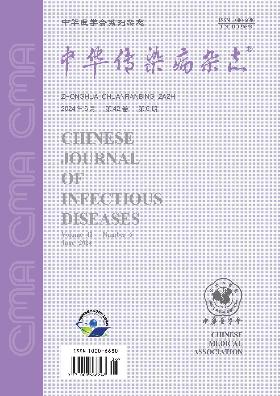Clinical analysis of risk factors for severe patients with novel coronavirus pneumonia
引用次数: 13
Abstract
Objective To analyze the clinical features of patients with coronavirus disease 2019 (COVID-19) in Shanghai and to investigate the risk factors for disease progression to severe cases. Methods The clinical data of 292 adult patients with COVID-19 hospitalized in Shanghai Public Health Clinical Center from January 20, 2020 to February 10, 2020 were retrospectively analyzed, including 21 severe patients and 271 mild patients. The demographic characteristics, epidemiological history, history of underlying diseases and laboratory examinations were compared between the two groups. Measurement data were compared using t test or Mann-Whitney U test. The count data were compared using hi-square test. The binary logistic regression equation was used to analyze the risk factors for the progression of patients to severe cases. Results Among the 292 patients, 21 were severe cases with the rate of 7.2% (21/292). One patient died, and the mortality rate was 4.8% in severe patients. The severe patients aged (65.0±15.7) years old, 19 (90.5%) were male, 11 (52.4%) had underlying diseases, 7 (33.3%) had close relatives diagnosed with COVID-19. The mild patients aged (48.7±15.7) years old, 135 (49.8%) were male, 74 (27.3%) had underlying diseases, 36 (13.3%) had close relatives diagnosed with COVID-19. The differences between two groups were all significant statistically ( t =-4.730, χ 2 =12.930, 5.938 and 4.744, respectively, all P <0.05). Compared with the mild patients, the levels of absolute numbers of neutrophils, alanine aminotransferase, aspartate aminotransferase, lactate dehydrogenase, creatinine, serum cystatin C, C reactive protein (CRP), procalcitonin , D -dimer, pro-B-type natriuretic peptide (proBNP), serum myoglobin, creatine kinase (CK), creatine kinase isoenzyme (CK-MB), serum troponin I (cTnI) in severe patients were all significantly higher ( U =2 091.5, 1 928.0, 1 215.5, 729.0, 1 580.5, 1 375.5, 917.5, 789.5, 1 209.0, 1 434.0, 638.0, 964.5, 1 258.0 and 1 747.5, respectively, all P <0.05), while the levels of lymphocyte count, albumin, transferrin, CD3 + T lymphocyte count, CD8 + T lymphocyte count and CD4 + T lymphocyte count in severe patients were all significantly lower ( U =1 263.5, t =4.716, U =1 214.0, 962.0, 1 167.5 and 988.0, respectively, all P <0.05). Further logistic regression analysis showed that the albumin (odds ratio ( OR )=0.806, 95% CI 0.675-0.961), CRP ( OR =1.016, 95% CI 1.000-1.032), serum myoglobin ( OR =1.010, 95% CI 1.004-1.016), CD3 + T lymphocyte count ( OR =0.996, 95% CI 0.991-1.000) and CD8 + T lymphocyte count ( OR =1.006, 95% CI 1.001-1.010) at admission were independent risk factors for the progression of COVID-19 patients to severe illness (all P <0.05). Conclusions Severe cases of patients with COVID-19 in Shanghai are predominantly elderly men with underlying diseases. Albumin, CRP, serum myoglobin, CD3 + T lymphocyte count and CD8 + T lymphocyte count could be used as early warning indicators for severe cases, which deserve more clinical attention.新型冠状病毒肺炎重症患者危险因素临床分析
目的分析上海市2019冠状病毒病(新冠肺炎)患者的临床特点,探讨疾病进展为重症的危险因素。方法回顾性分析2020年1月20日至2月10日在上海市公共卫生临床中心住院的292例成年新冠肺炎患者的临床资料,包括21例重症患者和271例轻症患者。比较两组患者的人口学特征、流行病学史、基础疾病史和实验室检查。使用t检验或Mann-Whitney U检验对测量数据进行比较。计数数据采用希方检验进行比较。二元逻辑回归方程用于分析患者进展为重症的危险因素。结果292例患者中,重症21例,占7.2%(21/292)。一名患者死亡,重症患者死亡率为4.8%。重症患者年龄(65.0±15.7)岁,男性19例(90.5%),有基础疾病11例(52.4%),有近亲属诊断为新冠肺炎7例(33.3%)。轻症患者年龄为(48.7±15.7)岁,135例(49.8%)为男性,74例(27.3%)有潜在疾病,36例(13.3%)有近亲诊断为新冠肺炎。两组差异均有统计学意义(t=-4.730,χ2=12.930,5.938和4.744,均P<0.05),B型钠尿肽原(proBNP)、血清肌红蛋白、肌酸激酶(CK)、肌酸激酶同工酶(CK-MB)、血清肌钙蛋白I(cTnI)在重症患者中均显著升高(U分别为2 091.5、1 928.0、1 215.5、729.0、1 580.5、1 375.5、917.5、789.5、1 209.0、1 434.0、638.0、964.5、1 258.0和1 747.5,均P<0.05),重症患者CD3+T淋巴细胞、CD8+T淋巴细胞和CD4+T淋巴细胞计数均显著降低(分别为U=1 263.5、T=4.716、U=1 214.0、962.0、1 167.5和988.0,均P<0.05),血清肌红蛋白(OR=1.010、95%CI 1.004-1.016),入院时CD3+T淋巴细胞计数(OR=0.96,95%CI 0.991-1.000)和CD8+T淋巴细胞数(OR=1.006,95%CI 1.001-1.010)是新冠肺炎患者发展为重症的独立危险因素(均P<0.05)。白蛋白、CRP、血清肌红蛋白、CD3+T淋巴细胞计数和CD8+T淋巴细胞数可作为重症病例的早期预警指标,值得临床重视。
本文章由计算机程序翻译,如有差异,请以英文原文为准。
求助全文
约1分钟内获得全文
求助全文
来源期刊
自引率
0.00%
发文量
5280
期刊介绍:
The Chinese Journal of Infectious Diseases was founded in February 1983. It is an academic journal on infectious diseases supervised by the China Association for Science and Technology, sponsored by the Chinese Medical Association, and hosted by the Shanghai Medical Association. The journal targets infectious disease physicians as its main readers, taking into account physicians of other interdisciplinary disciplines, and timely reports on leading scientific research results and clinical diagnosis and treatment experience in the field of infectious diseases, as well as basic theoretical research that has a guiding role in the clinical practice of infectious diseases and is closely integrated with the actual clinical practice of infectious diseases. Columns include reviews (including editor-in-chief reviews), expert lectures, consensus and guidelines (including interpretations), monographs, short monographs, academic debates, epidemic news, international dynamics, case reports, reviews, lectures, meeting minutes, etc.

 求助内容:
求助内容: 应助结果提醒方式:
应助结果提醒方式:


